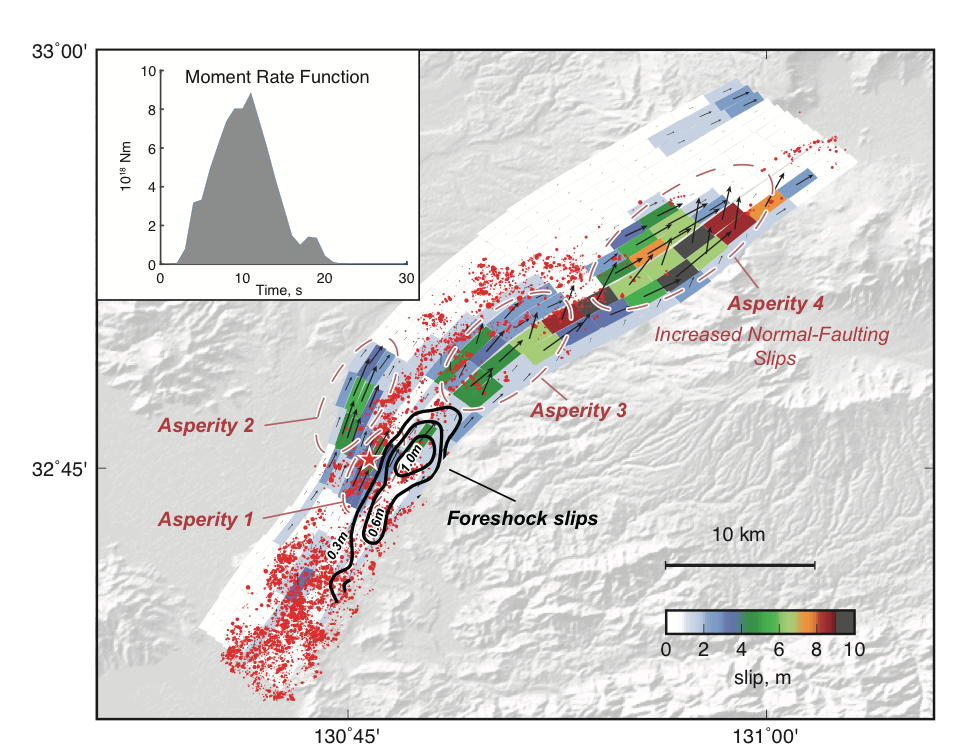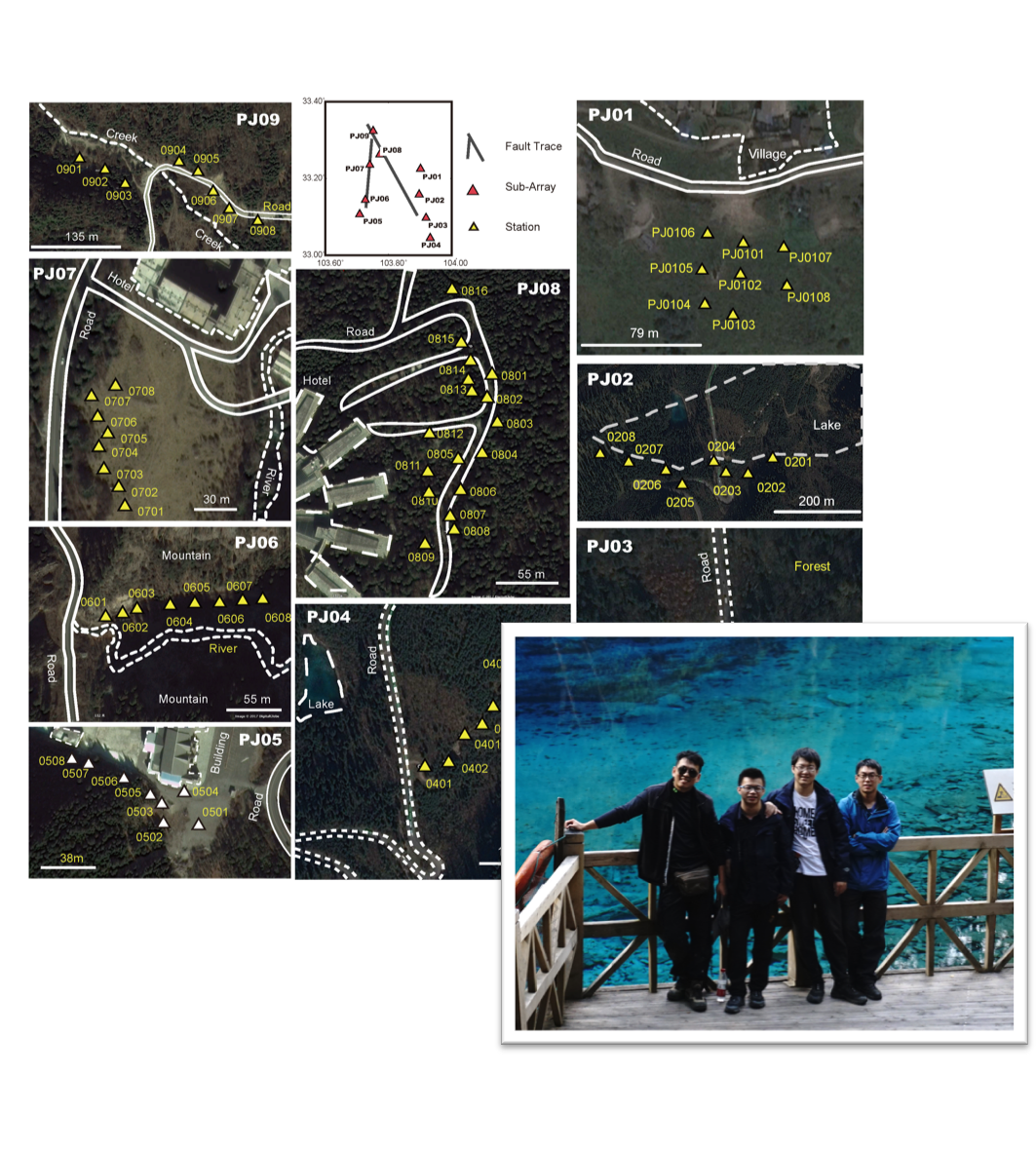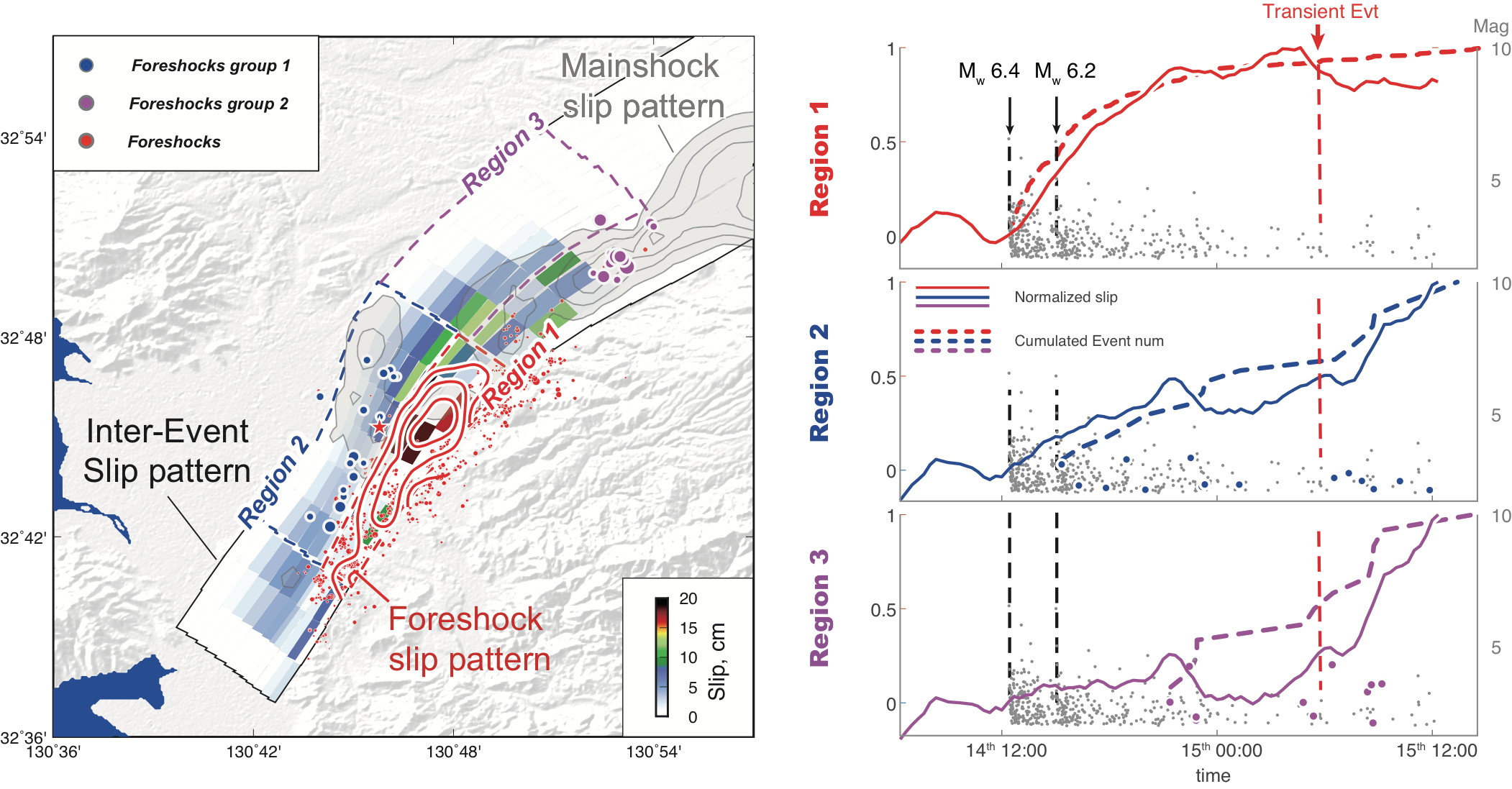SCHOOL OF EARTH AND SPACE SCIENCES, PEKING UNIVERSITY • Associate,Assistant Professor
E-mail:
yue.han@pku.edu.cn
 Han Yue
Han Yue
SCHOOL OF EARTH AND SPACE SCIENCES, PEKING UNIVERSITY • Associate,Assistant Professor
E-mail:
yue.han@pku.edu.cn
2007 Peking University B.S.
2010 Peking University M.S.
2014 UC Santa Cruz Ph.D.
2014-2017 Caltech Post-Doc Research Fellow
2017- 2023 Peking University Assistant Professor
2023- Peking University Associate Professor
Academic Honors
2016 National Young Scientist Program
2014 Caltech Seismo-Lab Director Post-Doc Fellowship
2013 Outstanding Self-financed fellowship of Chinese Government
1.Rupture process determination of Big earthquakes
Determining the rupture process of big earthquakes is the fundamental of earthquake studies, which also plays an important role in disaster relieving operations. In modern days, this task requires integrated adoption of seismic, geodetic and geologic observations. Because different observations have respective sensitivity to spatial and temporal information of the rupture processes, joint inversion exploit the different information achieving high resolution and stable inversion results.
Besides joint inversion, different inversion methods, e.g. linear or non-linear approaches and source parameterization methods, e.g. finite fault model and multi-point source, provides constraints of rupture processes from different perspectives. Below is the rupture model of the 2016 Kumamoto earthquake obtained by joint inversion of strong motion and geodetic observations.

Imaging technique is another strategy to determine the rupture processes. Adopting beam-forming techniques in global seismic networks, we can image the spatial and temporal information of the rupture processes. However, complicated earth structure is another source producing coherent energy of source images. These “artificial sources” need to be discriminated from real earthquake sources when interpreting the source images. We determined localized water reverberation phases produced by ocean bottom geometry, which was mis-interpreted as secondary sources. In the following figure, we show the wave field snapshot near the ocean floor and how such waves could be beamformed as coherent radiators.

2. Small earthquake detection
Besides large earthquakes, the fault also release elastic energy through small events. These small event serve as indicators for the fault geometry and stress loading and releasing processes. Thus detection of these small events is an important strategy to learn the physical structure and behavior of fault systems. My group probe into this problem through seismic network design and detection algorithms.
After the 2017 Jiuzhaigou earthquake, the research group of Han Yue and Shiyong Zhou deployed 80 short period seismic stations near the source region to detect aftershock activities. This network is locally refined as 9 sub-arrays, each composed of 8-16 seismic stations. Signal enhancement algorithms are designed for this network for better detection of aftershocks.

My group also achieve small event detection through artificial intelligence (AI) algorithms. As a popular machine learning algorithm, deep learning is widely used in research areas, which has large amount of training data. In seismology, the most straight forward application of deep learning is in the phase identification studies. We adopted convolutional and recurrent neural networks (CNN and RNN) in the event detection and phase picking algorithms and use manually picked P and S phases to train the network. The trained neural network achieved detection accuracy of higher than 98%. The following diagram shows the flowchart of the CNN and RNN neural networks.

3. Physical processes of fault systems
Besides the abrupt stress releasing process, i.e. earthquakes, the fault also release stresses through slow processes, e.g. slow-sips and creeping. These slow slips reflects the stress loading and releasing of fault planes, which may also reflects nucleation processes before big earthquakes. Therefore, these transitional slow-slip processes may provide useful information for earthquake short term predictions. In the study of 2016 Kumamoto earthquake, our group found transitional slow-slip signals from local GPS data before the mainshock, which may be associated with the nucleation of the mainshock. The following figure shows the GPS timeseries and seismic activities before the 2016 Mw 7.0 Kumamoto earthquake.

2024
47. C Ren, Z Wang, T Taymaz, N Hu, H Luo, Z Zhao, H Yue*, X Song*, Z Shen, H Xu, J Geng et al. Supershear triggering and cascading fault ruptures of the 2023 Kahramanmaraş, Türkiye, earthquake doublet[J]. Science, 2024, 383(6680): 305-311.
46. Lu W, Zhao Z, Yue H*, et al. The accessible seismological dataset of a high-density 2D seismic array along Anninghe fault[J]. Earthquake Science, 2024, 37(1): 67-77.
2023
45. Lu R, Yue H*, Lai X, et al. Quakes of Compact Stars[J]. Monthly Notices of the Royal Astronomical Society, 2023: stad270.
44. Zhao, Z., & Yue, H.* (2023). A two-step inversion for fault frictional properties using a temporally varying afterslip model and its application to the 2019 Ridgecrest earthquake. Earth and Planetary Science Letters, 602, 117932.
2022
43. Yue H*, Wang K., Xue L., Shen Z. Sun J., Postseismic process inversion using full time series of surface deformation: Full Time-series Inversion (FTI) theory and its application to the 2017 Sarpol-e Zahab earthquake, JGR: Solid Earth, e2021JB023317.
42. Ren C, Yue H*, Cao B, et al. (2022) Rupture process of the 2020 Mw= 6.9 Samos, Greece earthquake on a segmented fault system constrained from seismic, geodetic, and tsunami observations[J]. Tectonophysics, 839: 229497.
41. Yun N, Yue H*, Zhou S, et al. (2022) Absolute tectonic stress inversion in the 2016 Mw 7.0 Kumamoto earthquake source region using topography and rupture models[J]. JGR: Solid Earth, 127(8): e2021JB023204.
40. Zhou Y, Yue H, Zhou S, et al. Microseismicity along Xiaojiang Fault Zone (Southeastern Tibetan Plateau) and the characterization of interseismic fault behavior[J]. Tectonophysics, 2022, 833: 229364.
39. Zhou, Y., Ren, C., Ghosh, A., Meng, H., Fang, L., Yue, H., ... & Su, Y. (2022). Seismological Characterization of the 2021 Yangbi Foreshock‐Mainshock Sequence, Yunnan, China: More than a Triggered Cascade. JGR: Solid Earth, e2022JB024534.
38. Wang Z, Yue H*. (2022) Resolving Shallow Moment Releases of Megathrust Earthquakes by Empirical Green’s Function‐Based Inversions: A New Approach for Tsunami Warning[J]. JGR: Solid Earth, 127(7): e2021JB023765.
37. Yue H*, Shen Z K, Zhao Z, et al. (2022) Rupture process of the 2021 M7. 4 Maduo earthquake and implication for deformation mode of the Songpan-Ganzi terrane in Tibetan Plateau[J]. Proce. Nat. Ac. Sci., 2022, 119(23): e2116445119.
36. Lu, W., Zhou, Y., Zhao, Z., Yue, H.*, & Zhou, S. (2021). Aftershock sequence of the 2017 M w 6.5 Jiuzhaigou, China earthquake monitored by an AsA network and its implication to fault structures and strength. GJI, 228(3), 1763-1779.
35. Jia, B., Yue, H.*, & Muzli, M. (2021). Absence of Near‐Trench Early Triggering during the 2012 Mw 7.2 Indian Ocean Strike‐Slip Earthquake: Evidence from One‐Day Aftershocks. SRL.
2021
34. Yue, H.*, Sun, J., Wang, M., Shen, Z., Li, M., Xue, L., & Lay, T. (2021). The 2019 Ridgecrest, California earthquake sequence: Evolution of seismic and aseismic slip on an orthogonal fault system. EPSL, 570, 117066.
33. Guns, K. A.*, Pollitz, F. F., Lay, T., & Yue, H. (2021). Exploring GPS observations of postseismic deformation following the 2012 MW7. 8 Haida Gwaii and 2013 MW7. 5 Craig, Alaska earthquakes: Implications for viscoelastic Earth structure. JGR:Solid Earth, 126(7), e2021JB021891.
32. Zhou, Y., Yue, H., Fang, L., Zhou, S.*, Zhao, L., & Ghosh, A. (2021). An earthquake detection and location architecture for continuous seismograms: phase picking, association, location, and matched filter (PALM). SRL.
31. Ren, C., Yue, H.*, Wang, T., & Zhao, Z. (2021). Source rupture model of the 2018 M W 6.7 Iburi, Hokkaido earthquake from joint inversion of strong motion and InSAR observations. Earthquake Science, 34(1), 88-101.
2020
31. An, C., Shawn Wei, S., Cai, C., & Yue, H. (2020). Frequency limit for the pressure compliance correction of ocean‐bottom seismic data. Seismological Research Letters, 91(2A), 967-976.
30. Yue, H. *, & Lay, T. (2020). Resolving complicated faulting process using multi‐point‐source representation: Iterative inversion algorithm improvement and application to recent complex earthquakes. Journal of Geophysical Research: Solid Earth, 125(2), e2019JB018601.
29. Yue, H.*, Zhang, Y., Ge, Z., Wang, T., & Zhao, L. (2020). Resolving rupture processes of great earthquakes: Reviews and perspective from fast response to joint inversion. Science China Earth Sciences, 63(4), 492-511.
2019
28. Yun N, Zhou S*, Yang H*, Yue H. & Zhao L , (2019). Automated Detection of Dynamic Earthquake Triggering by the High‐Frequency Power Integral Ratio[J]. Geophysical Research Letters, 44(22), doi.org/10.1029/2019GL083913
27. Lo, Y. C., Yue, H.*, Sun, J., Zhao, L., & Li, M. (2019). The 2018 Mw6. 4 Hualien earthquake: Dynamic slip partitioning reveals the spatial transition from mountain building to subduction. Earth and Planetary Science Letters, 524, 115729.
26. Zhou, Y., Yue, H.*, Kong, Q., & Zhou, S. (2019). Hybrid Event Detection and Phase‐Picking Algorithm Using Convolutional and Recurrent Neural Networks. Seismological Research Letters, 90(3), 1079-1087.
2018
25. Xibin T*, Yue H., Yiduo L, Yiduo Liu, Xiwei Xu, Feng Shi, Chong Xu, Zhikun Ren, J Bruce H Shyu, Renqi Lu, Haijian Hao, Topographic loads modified by fluvial incision impact fault activity in the Longmenshan thrust belt, eastern margin of the Tibetan plateau[J]. Tectonics, 2018, 10.1029/2017TC004864
24. Yue, H.*, Yijian Zhou, Shiyong Zhou, Li M, Huang Y., Zhou L., Liu Z.,. The 2017 Jiuzhaigou Earthquake Aftershock‐Monitoring Experimental Network: Network Design and Signal Enhancement Algorithm[J]. Seismological Research Letters, 2018, 89(5): 1671-1679.
23. Sun J, Yue H*, Shen Z, Zhan Y. Fang L. Zhan Y., Sun X., The 2017 Jiuzhaigou earthquake: A complicated event occurred in a young fault system[J]. Geophysical Research Letters, 2018, 45(5): 2230-2240.
22. Wang W., Luo R., Yue H., Chen,X., Lee, K., Xu, R., FRB 121102: A Starquake-induced Repeater?[J]. The Astrophysical Journal, 2018, 852(2): 140.
2017
21. Yue, H. *, Z. E. Ross, C. Liang, S. Michel, H. Fattahi, E. Fielding, A. Moore, Z. Liu, and B. Jia, The 2017 Kumamoto earthquake: a significant event in a fault-volcanic system. JGR: Solid Earth 2017, 122(11): 9166-9183.
20. Yue H*. J. Castol, C. Yu, L. Meng, Z. Zhan. Localized water reverberation phase and its impact on back-projection results. GRL, 2017, 44(19): 9573-9580.
19. Chao A. Yue H. Sun J*. Meng L. Two-stage rupture process of the 2015 Illapel earthquake. BSSA, 2017, 107(5): 2416-2426.
2016
18. L. Li, K.F. Cheung, Yue H., T Lay and Yefei Bai, Effects of dispersion in tsunami Green’s functions and implications for joint inversion with seismic and geodetic data: a case study of the 2010 Mentawa. GRL,2016,43(21)
17. S Xu, E Fukuyama, Yue H., JP Ampuero Simple Crack Models Explain Deformation Induced by Subduction Zone Megathrust Earthquakes, BSSA, 2016, 106(5): 2275-2289.
16. Yue H. , Simons M., Duputel Z. Jiang J., Fielding E., Liang C., Owen S., Moore A., Riel B., Ampuero J.P. and Samsonov S.V., Depth varying rupture properties during the 2015 Mw 7.8 Gorkha (Nepal) earthquake, Tectonophysics. http://dx.doi.org/10.1016/j.tecto.2016.07.005
2015
15. Yue H, Lay T, Li L, et al. Validation of linearity assumptions for using tsunami waveforms in joint inversion of kinematic rupture models: Application to the 2010 Mentawai Mw 7.8 tsunami earthquake[J]. Journal of Geophysical Research: Solid Earth, 2015, 120(3): 1728-1747.
14. Hill E., Yue H., Barbot S., Hubbard J. Lay T., Hermawan I., Tapponnier P. Banerjee P., Feng L., Natawidjaja D. Sieh K. The 2012 Mw 8.6 Wharton Basin earthquake from joint inversion of high-rate GPS and teleseismic data: Thermal runaway on young faults. J. Geophys. Res. . 2015, DOI: 10.1002/2014JB011703
2014
13. Yue H, Lay T, Rivera L, et al. Localized fault slip to the trench in the 2010 Maule, Chile Mw= 8.8 earthquake from joint inversion of high‐rate GPS, teleseismic body waves, InSAR, campaign GPS, and tsunami observations[J]. J. Geophys. Res., 2014,: DOI: 10.1002/2014JB011340
12. Yue H, Lay T, Rivera L, et al. Rupture process of the 2010 Mw 7.8 (2014), Mentawai tsunami earthquake from joint inversion of near‐field hr‐GPS and teleseismic body wave recordings constrained by tsunami observations. J. Geophys. Res., 2014, 119(7): 5574-5593.DOI: 10.1002/2014JB011082
11. Lay T, Yue H, Brodsky E E, et al. The 1 April 2014 Iquique, Chile, Mw 8.1 earthquake rupture sequence. Geophys Res. Lett., 2014. DOI: 10.1002/2014GL060238
2013
10. Yue, H., T. Lay, J. T. Freymueller, K. Ding, L. Rivera, N. A. Ruppert, and K. D. Koper (2013), Supershear rupture of the 5 January 2013 Craig, Alaska (Mw 7.5) earthquake, J. Geophys. Res. 2013JB010594;doi:10.1002/2013JB010594
9. Yue H., T. Lay, S. Y. Schwartz, L. Rivera, M. Protti, T. H. Dixon, S. Owen and A. V. Newman, (2013) The 5 September 2012 Nicoya, Costa Rica Mw 7.6 earthquake rupture process from joint inversion of high-rate GPS, strong-motion, and teleseismic P wave data and its relationship to adjacent plate boundary interface properties. J. Geophys. Res. 2013JB010187 doi:10.1002/jgrb.50379
8. Yue, H. and T. Lay (2013), Source Rupture Models for the Mw 9.0 2011 Tohoku Earthquake from Joint Inversions of High-Rate Geodetic and Seismic Data. Bull. Seis. Soc. Amer. May 2013103:1242-1255; doi:10.1785/0120120119
2012
7. Yue, H, T. Lay and K. D. Koper (2012), En Echelon and Orthogonal Fault Ruptures of the 11 April 2012 Great Intraplate Earthquakes. Nature, 490, 245-249, doi:10.1038/nature11492.
6. Yue, H., Y. J. Chen, E. Sandvol, J. Ni, T. Hearn, S. Zhou, Y. Feng, Z. Ge, A. Trujillo, Y. Wang, G. Jin, M. Jiang, Y. Tang, X. Liang, S. Wei, H. Wang, W. Fan, and Z. Liu (2012), Lithospheric and upper mantle structure of the northeastern Tibetan Plateau, J. Geophys. Res., 117, B05307, doi:10.1029/2011JB008545.
5. Lay, T., H. Kanamori, C. J. Ammon, K. D. Koper, L. Ye, H. Yue, and T. M. Rushing (2012), Depth-varying rupture properties of subduction zone megathrust faults, J. Geophys. Res., 117, B04311, doi:110.1029/2011JB009133.
2011
4. Yamazaki, Y., T. Lay, K. F. Cheung, H. Yue, and H. Kanamori (2011), Modeling near-field tsunami observations to improve finite-fault slip models for the 11 March 2011 Tohoku earthquake, Geophys. Res. Lett., 38, L00G15, doi:10.1029/2011GL049130.
3. Yue, H., and T. Lay (2011), Inversion of high-rate (1 sps) GPS data for rupture process of the 11 March 2011 Tohoku earthquake (Mw 9.1), Geophys. Res. Lett., 38, L00G09, doi:10.1029/2011GL048700.
2010 - previous
2. Wei, S.,Y. J. Chen, E. Sandvol, S. Zhou, H. Yue, G. Jin et. al. (2010), Regional earthquakes in northern Tibetan Plateau: Implications for lithospheric strength in Tibet, Geophys Res. Lett, 37(19), L19307.
1. Yue H., Zhang Z. and Chen Y. J., (2008) Interaction between adjacent left-lateral strike-slip faults and thrust faults: the 1976 Songpan earthquake sequence. Chiness Sci. Bull. Volume 53, Number 16, 2520-2526, DOI: 10.1007/s11434-008-0210-z.
Graduate Student
 Chunmei Ren
Chunmei Ren
Ph.D. Candidate
Research Direction:
Rupture process inversion using joint inversion techniques

![]() Weifan Lu
Weifan Lu
Ph.D. Candidate
Research Direction:
Micro-seismic activity detection and catalog analysis
 Naidan Yun
Naidan Yun
Ph.D. Candidiate
Research Direction:
Absolute stress field inversion using earthquake data

Zexin Wang
Ph.D. Candidate
Research Direction:
Rupture process of large earthquakes using empirical Green's function, back-projection and numerical methods
 Wei Liu
Wei Liu
Ph.D. Candidate
Research Direction:
Virtual source method and its application to study fault damage zone structures
Undergraduate Students
Ruipeng Lu
Yuan Yuan
Graduated Students
2020
Yijian Zhou Now at UC Riverside
2021
Bo Jia
2019
Huiyun Guo (Now at UCSC)
2020
Litong Huang (Now at UCSC)
2021
Binghao Wang (Now at USC)
Xi Chen (Now at ETH)